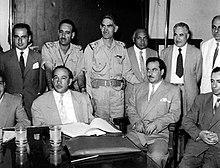Sovereignty Council (Iraq)
The Souveränitätsrat (Arabic مجلس السيادة, Majlis as-Siyada , English sovereignty council ) was that body that after the " Revolution of 14 July " 1958 (July Revolution) in Iraq as a collective head of state acted. The three-member sovereignty council anchored in the transitional constitution of 1958 in place of the abolished kingship , however, had only representative or ceremonial tasks; real power lay with Prime Minister Abd al-Karim Qasim .
Original composition 1958–1961
The members of the Sovereignty Council were not elected but were appointed by the Chairman of the Command Council of the Revolutionary Armed Forces (i.e. Prime Minister Qasim). Each of the three members represented one of the three main ethnic or religious groups of Iraq: Chairman Muhammad Najib ar-Rubai'i the Sunni Arabs and his two deputies Muhammad Mahdi Kubba and Khalid an-Naqschbandi the Shiite Arabs and the Sunni Kurds . On the one hand, it played a role that Qasim wanted the appointment of a respected Kurd to be understood as a benevolent gesture that was intended to secure the loyalty of the Kurds to him. The Shiite Kubba, on the other hand, was close to the conservative, Arab-nationalist Istiqlal party, which had participated in the revolution and whose support Qasim initially needed.
After the break between Qasim and the conservative nationalists, Kubba was urged to withdraw unofficially from the committee in March 1959 and politically sidelined. Until Naqschbandi's death in November 1961, the Sovereignty Council consisted of only two active members.
New members 1961–1963
On December 1, 1961, Qasim appointed two new members: the Kurd Rashad Arif and the Shiite Abd al-Majid Kamunah . Muhammad Najib ar-Rubai'i remained chairman of the Council of Sovereignty and was therefore mostly unceremoniously regarded as the actual head of state, although he was actually only primus inter pares .
With the overthrow of the Qasim regime in the revolution of February 8, 1963 (February Revolution, Ramadan Revolution), the Sovereignty Council was finally abolished and replaced by the newly created office of president. The first President of Iraq was Abd al-Salam Arif , who converted Iraq into a presidential republic after the military coup of November 18, 1963 (until 2003).
Individual evidence
- ↑ a b Peter Sluglett: Iraq since 1958 - From the revolution to the dictatorship , page 90. Suhrkamp, Frankfurt / M. 1991
- ↑ Mohammed Shafi Agwani: Communism in the Arab East , page 115f. Asia Publishing House, Calcutta 1969
- ↑ a b Yitzhak Oron (Ed.): Middle East Record 1961 , Volume 2, page 260. The Moshe Dayan Center, Tel Aviv 1961

